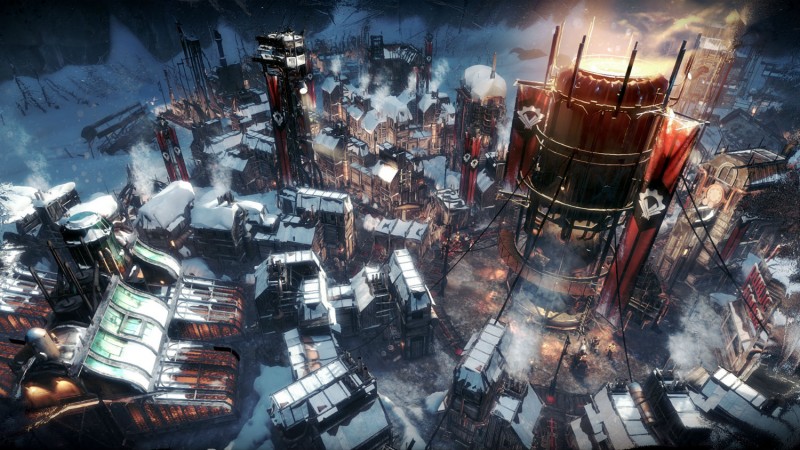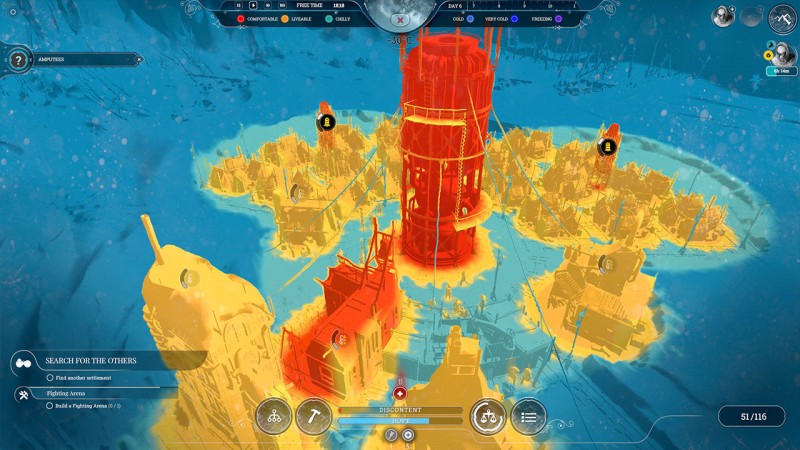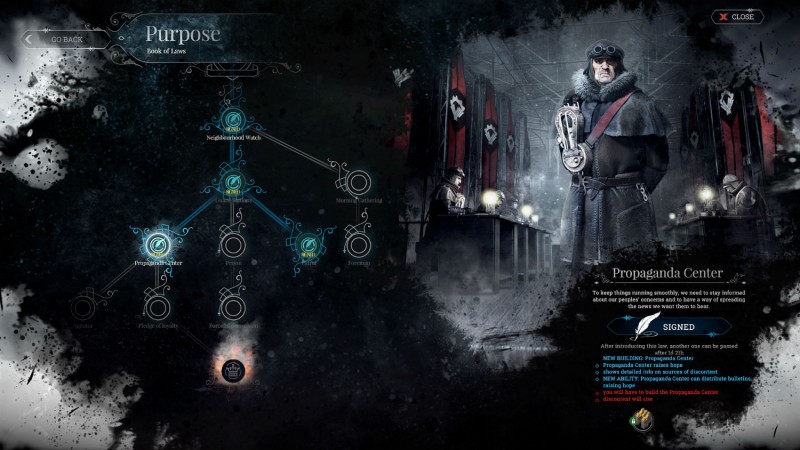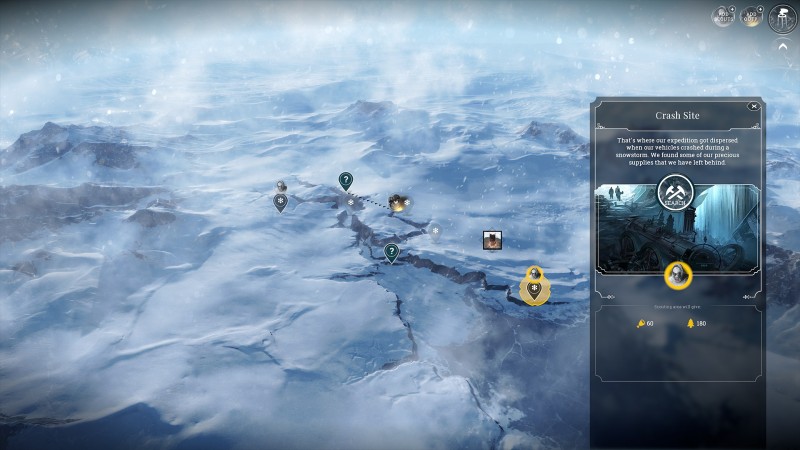15 Frostpunk Tips To Protect You From A Bloody Revolt

The world of Frostpunk is frigid, brutal, and uncaring. As you build up an outpost in the middle of nowhere, you will face a never-ceasing onslaught of crises, including an angry populace, dwindling resources, and the dawn of a new ice age that makes it nearly impossible to survive.
Like a grizzled survivor who has returned from the frontier a changed man, I’ve seen and done things I hope you never have to experience. Hundreds died during my reign – some from the weather, others from starvation – and I’m not proud. But I hope to pass on the lessons I’ve learned to hopefully make your leadership turn more successful than my own.

Check Your Heat Map Often
Heat is a precious resource when an ice age is setting in, so you need to monitor it often. If buildings get too cold, they cease production. If homes succumb to cold weather, your medical facilities may buckle under the stress of the sickly. This is why it’s important to always keep an eye on the temperature of your buildings. Once you install heaters in buildings or steam hubs, you have another layer of control over what buildings get warm.
Optimization can save you a lot of coal, so if you notice your city is glowing with warmth, turn a few heating elements off to preserve your precious stocks for when you really need it. You can also set steam hubs to run only during working hours, which is a great way to save energy when they are placed by places of employment.
You Can Upgrade Pre-Existing Buildings For Less
When you unlock facility improvements like the bunkhouse, house, or steam upgrades to your resource-gathering operations, you don’t need to place them on a fresh plot of land. If you build directly on top of the older building, you actually re-use the resources it took to construct the original, which drops the resource price significantly in some instances.
It’s Okay To Leave Buildings Empty
Frostpunk’s inhospitable world is indifferent to your min-maxing plans. Sometimes you just need to cease resource gathering on one material to throw workers at an urgent problem. If your medical posts are overflowing, pull some engineers off a project where you are running a surplus and squelch the sickness for a while. Once things are under control, you can return them to their original duties.
Pay special attention to medical posts at all times. If things are going well and your population is healthy, you may have workers sitting around twiddling their thumbs with nothing to do. If that’s the case, transfer them to another job until the need inevitably arises to employ more doctors.
This yo-yo approach to workforce management also means it’s smart to build more resource buildings than you may need at the time. If supply demands suddenly surge, it’s nice to be able to quickly open a new mine, sawmill, or thumper that has been waiting to be put to good use.
Keep Workshops Busy
Workshops are vital buildings that allow you to research new technologies, which is the best way to improve your efficiency. You should always make sure you have enough resources to put your researchers to work immediately after they complete their previous task.
After you get your beacon set up, you have a lot of tantalizing options. I recommend improving your hunting and exploration right away, then transitioning to researching the coal thumper, sawmill, and steelworks so you can scale up quickly. After that, you should heavily invest in heating technology to deal with the impending ice age.
Coal Thumpers Need Gathering Posts
The coal thumper produces more coal than the mines do, but it also requires more people to work the operation. The tutorial glances over this, but if you want your thumper to be at its maximum effectiveness, you need to pair it with two gathering posts. As you upgrade your thumper, you will need to increase the number of gathering posts around it as well.

Enact Only The Laws You Need
The book of laws extends in many directions, from forcing amputations and child labor to eventually declaring you an untouchable supreme ruler. All of these are at your disposal, but you are under no pressure to make the more egregious ones a part of your leadership platform.
Two laws I highly recommend enacting off the bat: Emergency Shift and Extended Shift. These aren’t permanent modifiers, but you can use them when things get tough to pull you out of a vortex. When a serious ice storm is on the horizon and you need to make multiple improvements to your heating infrastructure, having your research workshops work 24 hours straight can be a lifesaver. The same goes for extending shifts of coal workers when infrastructure improvements leave you at a resource deficit.
Never Leave Workers Idle
When your citizens leave work for the sick bay, the natural inclination is to replace them with new workers at vital facilities like the various coal operations. This means when they come back from sick leave, they won’t have a job assignment. Whenever you see an idle worker, which are indicated on the population widget at the bottom right of the screen, find them a new home.
Build Several Resource Depots
When things are going well, you may end up hitting your storage cap for a particular resource. Rather than sitting comfortably against the cap, unless your workers are desperately needed elsewhere it’s better to build resource depots and continue the gathering operation.
Queue Construction During The Day
Workers return from their jobs each night, but they don’t head straight to bed. If construction needs to be done, they tackle it during the evening. To make sure new operations are built quickly, place the new structures on the map before the work day is over. If you are in a pinch for time, you can also assign idle workers to construction projects during the day as well.
Keep Buildings Close To Each Other
When designing your city, try your best to build right next to your other dwellings. The reason is twofold. One, you only have so much room to build, so wasted space could come back to haunt you. Two, if you leave gaps, this creates places where the cold can penetrate your city and necessitate the addition of another steam core.

Optimize Your Scouts
You can form several teams of scouts to explore the area surrounding the city. They often find vital materials for your community to use, but don’t rush them home immediately after a discovery. If they are in a busy area where they could investigate several sites quickly, this is a better use of time than having them trek back and forth every time.
Steam Cores Are Invaluable
The one resource you cannot produce in your city is a steam core, which are used to build factories, automatons, and the higher level resource-gathering buildings. Take these whenever your scout teams find them. Because of their scarcity, think about their application before spending resources to make sure you are improving your operations in the best possible way.
Build Outposts
At a certain point in the game, you’ll come across abandoned mines that can either be harvested for supplies or re-opened by establishing an outpost. These outposts are lifesavers, as they can deliver vital supplies on a daily basis. I particularly recommend opening the coal mine, which delivers 800 units of coal a day. As your city grows and the temperature drops, you’ll need it.
Your Citizens Need Entertainment
Dissatisfaction can lead to revolt, so it’s important to bring some levity to your people’s lives. You can do this primarily by instituting new laws that allow fight houses, public houses, moonshine, and even brothels (though the last option also slowly drains hope, so be careful).
Automatons Are The Best
Seriously, the more steam-powered robots you can get to work your city, the better. They are our superiors. Unlike lazy humans, automatons can work 24/7, never get sick (though they sometimes break down), never revolt, and consume coal rather than food. Whenever you discover one during expeditions, send it back to your city and put it to work in one of your facilities. You can also create them in a factory, but the cost is steep. That said, the more robots you have working vital operations, the better.
Do you have other tips? Share them in the comments section below.

Get the Game Informer Print Edition!
Explore your favorite games in premium print format, delivered to your door.
- 10 issues per year
- Only $4.80 per issue
- Full digital magazine archive access
- Since 1991









